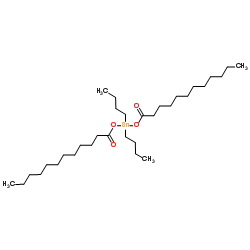Dibutyltin dillaurate

Dibutyltin dillaurate structure
|
Common Name | Dibutyltin dillaurate | ||
|---|---|---|---|---|
| CAS Number | 77-58-7 | Molecular Weight | 631.558 | |
| Density | 1.066 g/mL at 25 °C(lit.) | Boiling Point | 560.5±19.0 °C at 760 mmHg | |
| Molecular Formula | C32H64O4Sn | Melting Point | 22-24°C | |
| MSDS | Chinese USA | Flash Point | 292.8±21.5 °C | |
| Symbol |




GHS05, GHS07, GHS08, GHS09 |
Signal Word | Danger | |
|
The novel semi-biodegradable interpenetrating polymer networks based on urethane-dimethacrylate and epoxy-polyester components as alternative biomaterials.
Acta Bioeng. Biomech. 17 , 13-22, (2015) This paper presents the pilot study aimed at the development of new full interpenetrating polymer networks based on urethane- dimethacrylate and biodegradable epoxy-polyester as the proposition of new biomaterials with gradually emerging porosity.The urethane... |
|
|
Dispersion of titanate nanotubes for nanomedicine: comparison of PEI and PEG nanohybrids.
Dalton Trans. 44(2) , 739-46, (2014) In the present study, we report the dispersion of titanate nanotubes (TiONts) via polymer grafting (PolyEthylene Glycol, PEG) or polymer adsorption (polyethylene imine, PEI) where different TiONts/polymer ratios have been investigated. The TiONts/PEI and TiON... |
|
|
Synthesis and characterization of X-ray opaque polycarbonate urethane: Effect of a dihalogenated chain extender on radiopacity and hemocompatibility.
J. Biomed. Mater. Res. A 103 , 2214-24, (2015) An inherently radiopaque poly(carbonate urethane) containing fluorine and iodine atoms in the polymer chain was synthesized and characterized. Radiopaque polyurethane was synthesized from 1,6-diisocyanatohexane (HDI), poly (hexamethylene carbonate)diol (PHCD)... |
|
|
Towards controlled polymer brushes via a self-assembly-assisted-grafting-to approach.
Nat. Commun. 7 , 11119, (2016) Precise synthesis of polymer brushes to modify the surface of nanoparticles and nanodevices for targeted applications has been one of the major focuses in the community for decades. Here we report a self-assembly-assisted-grafting-to approach to synthesize po... |
|
|
PLA-PEG Coated Multifunctional Imaging Probe for Targeted Drug Delivery.
Mol. Pharm. 12 , 1885-92, (2015) Monitoring of drugs in vivo has been recognized as an urgent need for successful chemotherapy treatment. However, to find an appropriate tool for this purpose has been proved as a great challenge. Here, we report a PLA-PEG coated hollow X-ray and upconversion... |
|
|
Synthesis of antibacterial methacrylate monomer derived from thiazole and its application in dental resin.
J. Mech. Behav. Biomed. Mater. 49 , 61-8, (2015) A non-quaternary ammonium antibacterial methacrylate monomer MEMT derived from thiazole was synthesized and applied into UDMA/TEGDMA dental resin with a series of mass fraction (10 wt%, 20 wt%, and 30 wt%). Double bond conversion, polymerization shrinkage, wa... |
|
|
New injectable elastomeric biomaterials for hernia repair and their biocompatibility.
Biomaterials 75 , 182-92, (2015) Complications associated with implantation of polymeric hernia meshes remain a difficult surgical challenge. We report here on our work, developing for the first time, an injectable viscous material that can be converted to a solid and elastic implant in vivo... |
|
|
Assessment of antifouling efficacy of polyhedral oligomeric silsesquioxane based poly (urea-urethane-imide) hybrid membranes.
Lett. Appl. Microbiol. 61 , 274-82, (2015) A series of polyhedral oligomeric silsesquioxane (POSS) based poly(urea-urethane-imide) (PUUI-POSS) membranes were synthesized by varying the proportions of imide using 2,4-toluene diisocyanate (TDI) and bis(aminopropyl) terminated polydimethylsiloxane (PDMS)... |
|
|
Self-repairable polyurethane networks by atmospheric carbon dioxide and water.
Angew. Chem. Int. Ed. Engl. 53(45) , 12142-7, (2014) Sugar moieties were incorporated into cross-linked polyurethane (PUR) networks in an effort to achieve self-repairing in the presence of atmospheric carbon dioxide (CO2) and water (H2O). When methyl-α-D-glucopyranoside (MGP) molecules are reacted with hexamet... |
|
|
Effect of diisocyanate linkers on the degradation characteristics of copolyester urethanes as potential drug carrier matrices.
Eur. J. Pharm. Biopharm. 95 , 18-26, (2015) In this study, the effect of three aliphatic diisocyanate linkers, L-lysine diisocyanate ethyl ester (LDI), hexamethylene diisocyanate (HDI), and racemic 2,2,4-/2,4,4-trimethyl hexamethylene diisocyanate (TMDI), on the degradation of oligo[(rac-lactide)-co-gl... |